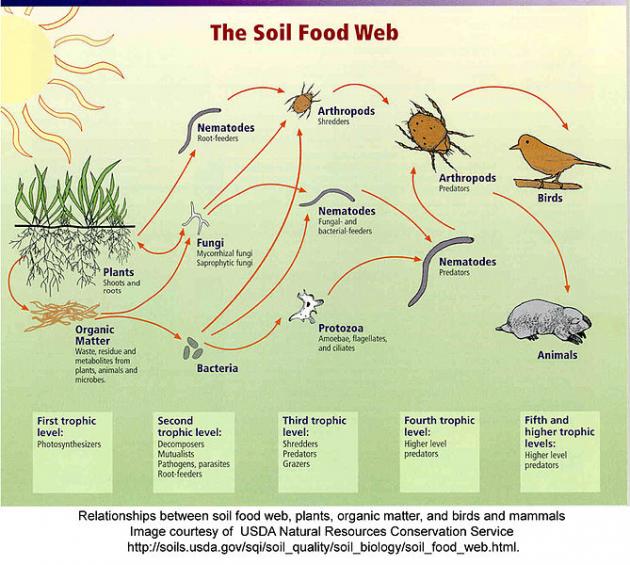
by Taylor Vandiver | Jan 22, 2015
You’re digging up a ridiculously stubborn patch of Florida betony when an earthworm crawls across your path. As you break apart the soil in your hands a world of active organisms is being sifted through your fingers. Fertile soil is teeming with beneficial microbes. It is estimated that there can be billions of microbes in a single gram of soil.
Bacteria, fungi, and protozoa are major players in soil microbial processes. They perform a variety of functions beneficial to soil and the plants growing in that soil. Other soil organisms of importance are nematodes, arthropods, and earthworms.

Soil Food Web. Photo courtesy USDA-NRCS.
Rather than being an inert material, soil houses a dynamic living ecosystem. Most soil organisms are too small to be seen, however they are still performing a great service to gardeners in many ways. These organisms are vitally important to improving the health of our soils. They also play a key role in making nutrients available to plants.
Soil organisms are naturally active during certain times of the year. Most are active during late spring and early summer when the soil is warm and moist. If the soil dries out during the summer months, soil organism activity will decline. During fall months, if there is rain or snow that moistens the soil while it is still warm, soil organisms may resume partial activity. As the soil cools in the fall, many organisms go dormant. It is important for gardeners to note that soil organisms help breakdown certain fertilizers and during the cool, dry months these fertilizers, if applied, will be less available for plants to take up.
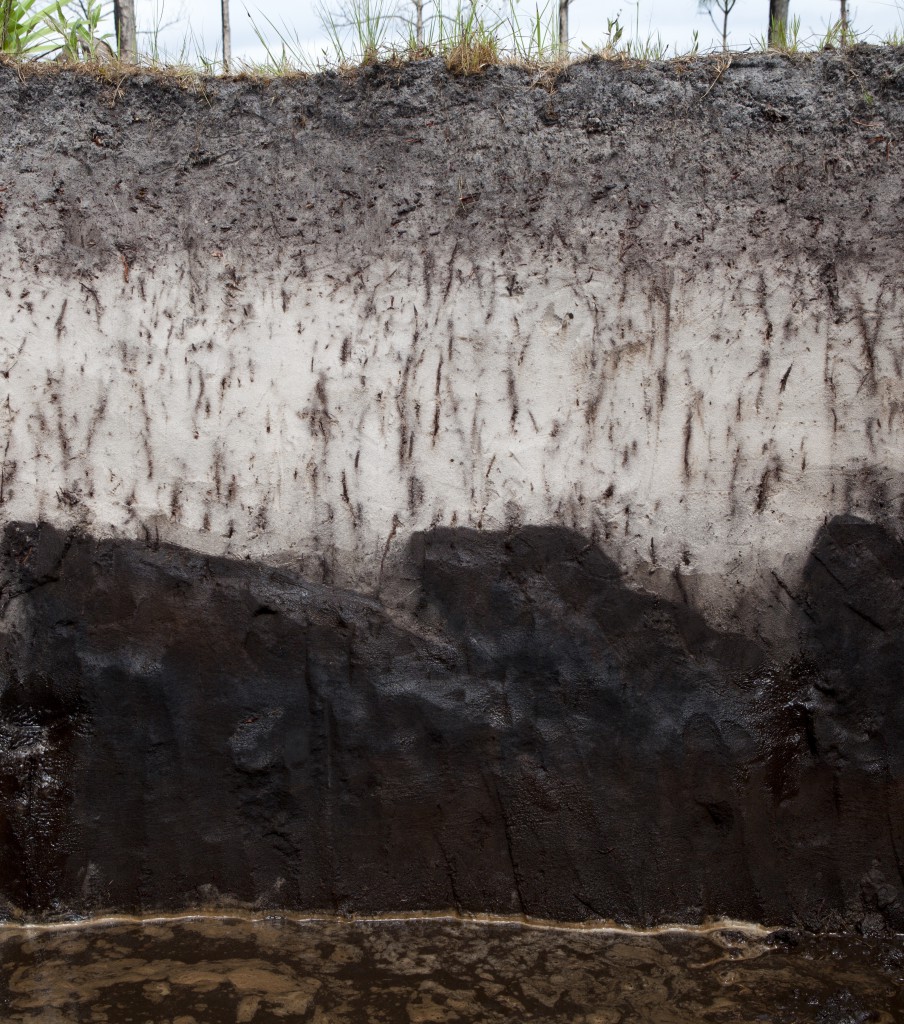
Soil profile. Photo courtesy UF/IFAS.
Soil organisms are generally placed within three categories: organisms that are beneficial to plants, organisms that play a neutral role in plant growth, and organisms that are harmful to plants. Creating a favorable environment for beneficial soil organisms can improve plant growth and reduce garden maintenance. Encouraging their efforts is key to building a healthy fertile soil. Here are some ways you can encourage beneficial organisms in your soil:
- Add organic matter to the soil. Soil organisms require a food source from soil amendments (compost, crop residues) and/or mulch.
- Water effectively. Soil organisms are happiest in an environment that is damp, but not soggy. (Avoid over-irrigation because waterlogged soils will be harmful to beneficial soil organisms)
- Avoid unnecessary tilling, as it can destroy the mycorrhizae and soil structure. Instead of tilling, mulch for weed control.
- Avoid pesticide applications that aren’t necessary. Some fungicides, insecticides and herbicides are harmful to various types of soil organisms.
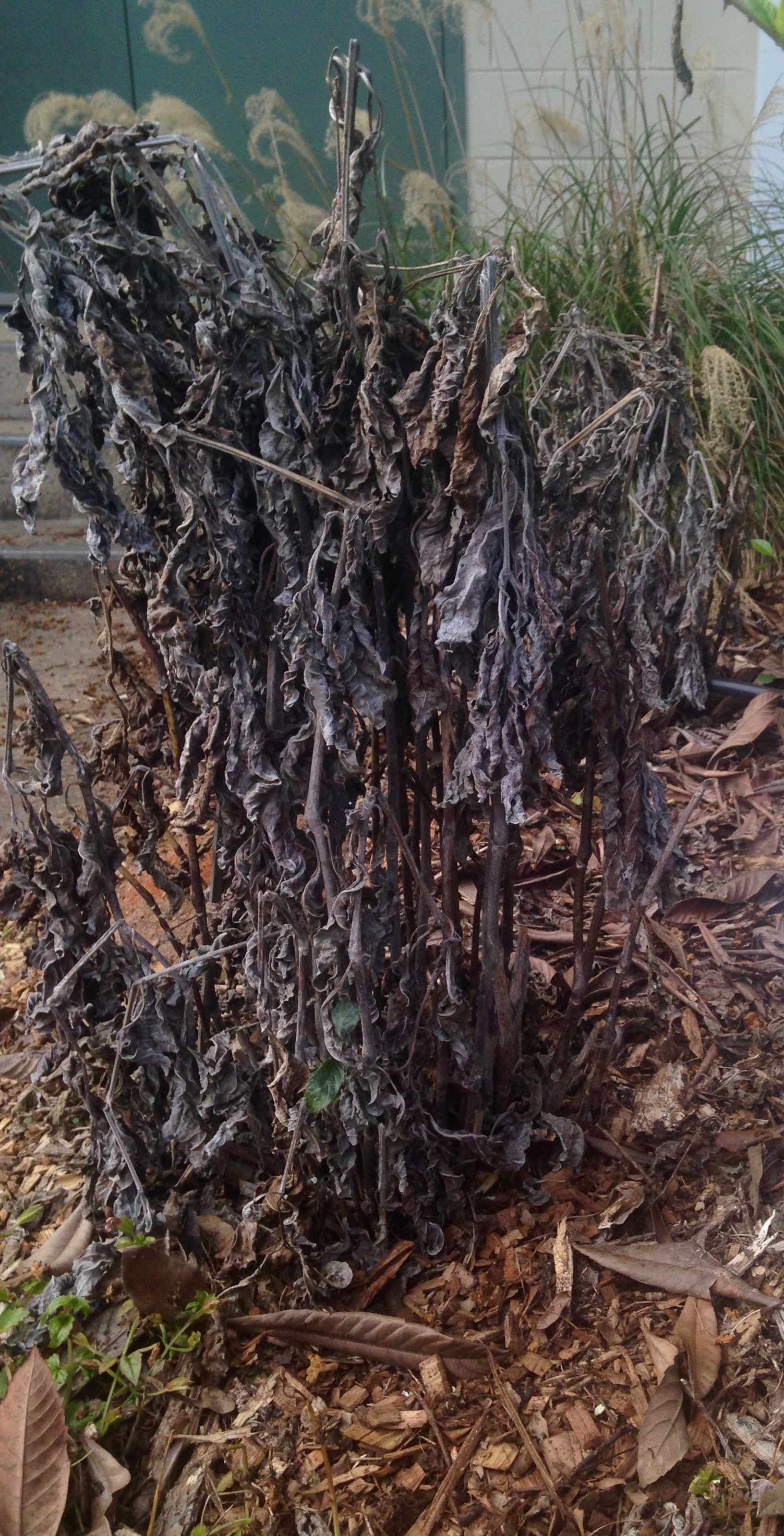
by Sheila Dunning | Dec 23, 2014
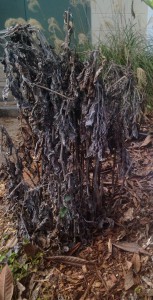
A frozen perennial plant. Photo credit: Taylor Vandiver UF/IFAS Extension.
When you look out at your landscape nobody has to tell you that winter temperatures in Northwest Florida Afterwards, the temperatures warm up and you feel compelled to do something about it. You just need to “turn your back and slam the door”. “Conceal, don’t feel; don’t let them know”. Cold injury can affect the entire plant or just certain plant or parts such as fruits, flowers, buds, leaves, trunks, stems, or roots. Many plant parts can adapt to tolerate cold. Root systems in the landscape are seldom ‘frozen’ in Florida. “The cold never bothered” them “anyway”. While dead, unsightly leaves may be removed as soon as they turn brown after a freeze, the remaining dry looking stems serve as food storage and should be allowed to remain. If they are removed before the weather is warm enough for the plant to resume growth, the root system may not be enough to support the plant and it will die. So, “let it go, let it go, let it go”. “The perfect” landscape “is gone”. “The past is in the past”. “It’s funny how some distance makes everything seem so small”.Tropical plants and summer annuals do not adapt or harden to withstand temperatures below freezing, and many suffer injury at temperatures below 50°F (10°C). Subtropical plants can harden or acclimate (become accustomed to a new climate) to withstand freezing temperatures, and properly conditioned temperate plants can withstand temperatures substantially below freezing.
Recently planted, unestablished plants may be more susceptible to cold injury. One type of winter injury is plant desiccation or drying out. This is characterized by marginal or leaf tip burn in mild cases and totally brown leaves in severe cases. Desiccation occurs when dry winds and solar radiation result in the loss of more water from the leaves than can be absorbed and/or transported by a cold root system. Plant water needs should be checked after a freeze. Plants may have lost substantial moisture during a windy freeze. Plants will transpire (lose water vapor) on a sunny day after a freeze. Cold injured wood can be identified by lightly scraping the bark with your fingernail and examining the color of the cambium layer (food conducting tissue) just underneath. Green tissue indicates the plant is still alive at that point; black or brown coloration indicates dead or injured tissue. 
After a particularly harsh cold event, some plants may be very slow to recover, so some patience is required. “It will rise” with “the break of spring”. Branch tips may be damaged while older wood is free of injury. Delay pruning until new growth appears next spring to ensure that live wood is not removed. In the meantime, take Elsa’s advice and “let it go, let it go, let it go”. You may be “too relieved to grieve”. I hope I haven’t infringed on any copyrights by letting you know “It’s okay to put off the yard work in the name of plant physiology”.
Enjoy the holiday season!
For more information please see:
Treating Cold Damaged Plants
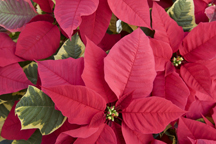
by Gary Knox | Dec 23, 2014
Poinsettias are one of the most popular plants during the Holiday Season. Poinsettias grow as shrubs in their native southern Mexico but have been bred to become compact, bushy plants perfect as container ornamentals. The showy “flowers” of poinsettias are actually modified leaves called bracts. Usually red in color, modern poinsettia breeding created showy bracts ranging in color from red to pink to white to orange, with lots of variegations and different leaf coloration patterns and sizes. The true flowers on poinsettias are the small green and yellow parts located in the center of each group of bracts.

Photo credit: Tyler Jones UF/IFAS.
Here are some do’s and don’ts to ensure that your poinsettias stay beautiful through the holidays and beyond:
- Do choose plants with true flowers that are greenish. Plants with unopened or newly opened flowers will last longer than those already sporting true flowers dusted with yellow pollen.
- Do choose plants that are bushy and leafy. Plants that have lost their lower leaves usually indicate the plant was mishandled and may decline quickly.
- Do place poinsettias in an area with bright light but not direct sunlight.
- Do keep poinsettias away from children and pets. Poinsettias are not poisonous but still might cause skin irritation and upset stomachs. People allergic to latex should be aware poinsettia sap contains latex-like materials.
- Don’t overwater poinsettias. Only water poinsettias when the top of the soil is dry, and let excess water drain away. Remove the poinsettia from the decorative foil wrapping to allow water to drain out.
- Don’t expose poinsettias to temperature extremes or drafty areas. Poinsettias like the same temperatures as people, so keep them away from cold (temperatures below 50) or heat (temperatures above 80).
After the holidays are over, you can plant poinsettias outdoors. For more information see:
Enjoy Your Poinsettias After the Holidays
In the meantime, enjoy your beautiful poinsettias and Happy Holidays!
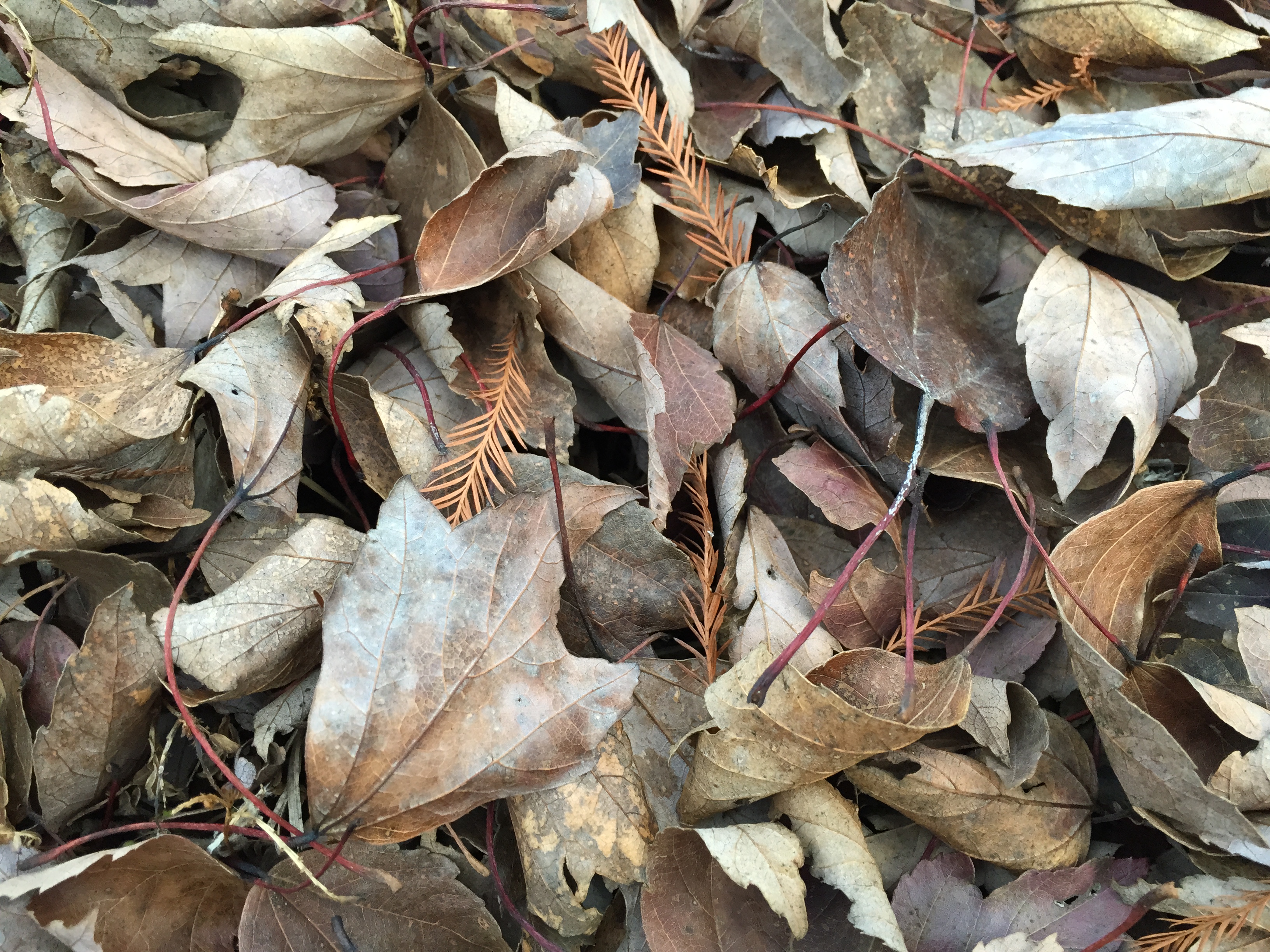
by Mary Salinas | Dec 16, 2014
This is the time of year when leaves are turning shades of yellow and red and falling from the trees. And this spurs homeowners to get out there with their rakes and rid them from their lawns. This is a good practice as too many leaves will shade out the grass and decrease the quality of the lawn come next spring. So, go ahead and rake them up. However, think about using as many as you can as mulch in other parts of your yard.
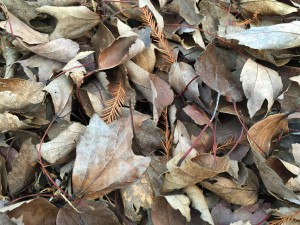
Leaves as mulch. Photo credit: Mary Derrick UF/IFAS Extension.
Leaves can be placed as mulch in landscape beds “as is” or chopped up with your mower or shredder into finer pieces and then spread around perennials, shrubs and trees. When chopped up or shredded, they tend to stay in place much better and don’t blow around when it gets windy. As the leaves break down over time, their nutrients are released and become available; that’s free fertilizer for your landscape plants. Leaves as mulch do have a natural look in the landscape, so if you prefer a more formal or polished look, you can spread a thin one-inch layer of a commercial mulch over the leaves.
Organic mulches (those made from plants) offer many benefits. They add organic matter and improve soil fertility as they decompose, thus reducing the need for added fertilizers. Mulch helps to maintain soil moisture so less frequent irrigation may be needed. Soil-borne disease can also be prevented as the soil does not splash up on the bottom leaves of plants during periods of rain. One of the favored reasons to use mulch is to prevent weeds in your landscape beds. And, of course, mulch is much prettier to look at than bare ground!
So how deep should you apply mulch? University of Florida experts advise a 3 to 4 inch layer of mulch around shrubs and trees. However, keep mulch from setting against the stems and trunks as that can cause moisture and pests to adversely affect them. Place just a thin one-inch layer of mulch over the rootballs of your plants.
Using leaves as mulch recycles a natural resource and saves you money, enriches your soil, fertilizes your plants and keeps them out of the local landfill.
For more information:
Landscape Mulches: What Are The Choices in Florida?
Mulch Recommendations
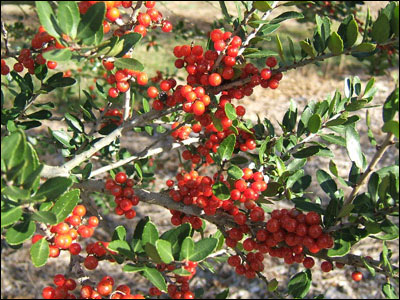
by Taylor Vandiver | Dec 16, 2014
Now that we’ve all been stuffed like a Thanksgiving turkey, it’s time to transition into the final and, arguably, most ornate holidays of the year. Right now you can hear your mantles and door frames crying out to be adorned. Your windows are begging for wreaths and giant red bows. And there may be a certain corner in your house that has been waiting all year for an evergreen, or two.
As we delve into the winter holidays our homes are being dressed to impress. There is nothing better than fresh foliage placed along a mantle or maybe a little mistletoe hanging from a previously unadorned beam. The scent of pine is in the air and I don’t know about you, but I’m ready to get decorating.
Here is a list of a few evergreen plants that make wonderful decorations for the season. You may even find some in your own backyard! Just make sure when you are removing foliage and fruit that you do it gently, so as not to harm the plant. Make all cuts at a 45 degree angle so that water will not pool on branch tips and rot. Also, if you forcefully remove foliage from a plant you could expose the susceptible cambium layer.
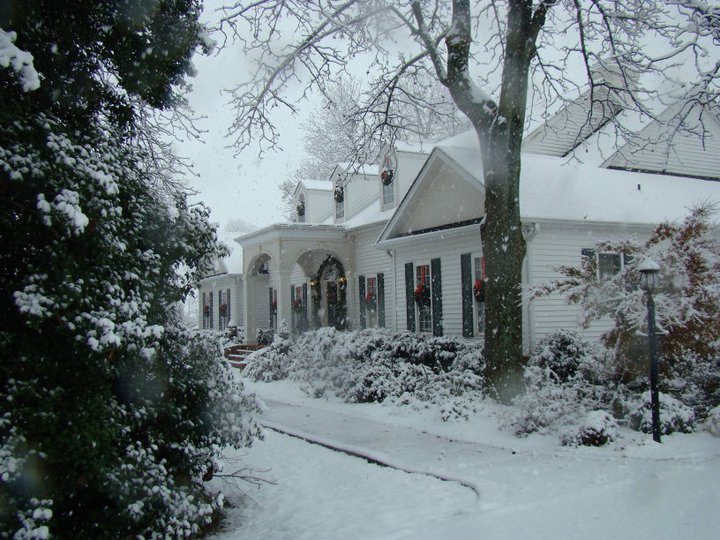
Wreaths and a decorated door frame add a bit of holiday cheer to this snowy scene. Photo courtesy Taylor Vandiver.
Traditional
Magnolia (Magnolia grandiflora) – This southern staple provides foliage that will liven up any banister or door frame. After being cut from the tree it can withstand the dryer temperatures indoors for days on end.
Hollies (Ilex spp.) – Hollies not only provide glossy green foliage, but bright red fruit that will beautifully adorn holiday arrangements and centerpieces.
Pine/Pinecones (Pinus spp.) – Pine trees offer a wispy presence to many decorations and their cones can give structure to wreaths and mantle pieces.
Boxwood (Buxus spp.) – Boxwoods are great for a touch of green.

Yaupon holly fruit and foliage. Photo courtesy UF/IFAS.
New Ideas
Abelia (Abelia x grandiflora) (evergreen to semi-evergreen) – Abelia are not commonly thought of when making holiday arrangements, but the texture of their foliage and the myriad of colors can spice up traditional decorations.
Aucuba (Aucuba japonica) – Aucuba offer a coarse texture that would pair well with the wispier pine foliage. Also, the gold dust variety will add a little more color to the mix.
Aspidistra (Aspidistra elatior) – Aspidistra foliage tends to feel more tropical. If you want to try a non-traditional arrangement these would work well and they can last for days provided a small amount of water.
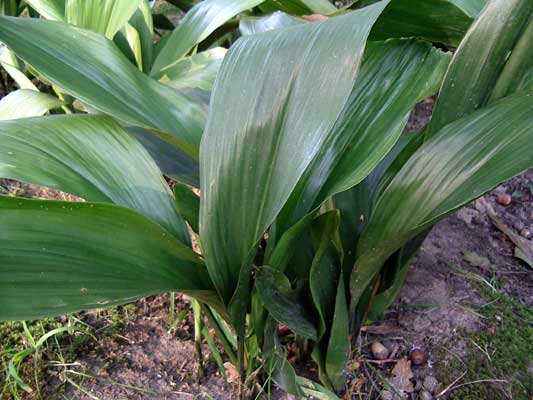
Aspidistra foliage that could easily be worked into a stunning arrangement.
Remember that a few well placed planters can liven up even the smallest spaces. Try using a small evergreen tree or shrub such as a magnolia, cypress / false cypress or arborvitae and surround them with poinsettia or pansies. You can try a smaller planter and add in pine cones, poinsettia, grasses, etc. Also if you are celebrating this holiday season with a live Christmas tree, then don’t be afraid to ask the grower/retail center for discarded branches. These can easily be formed into a wreath or used throughout the house. And since this is Florida there’s always the option of decorating your palm tree!

by Larry Williams | Dec 9, 2014
From about mid November or December to March, deciduous trees have little to no foliage making us more aware of their shapes, forms and barks.
Here are a few trees to consider for adding winter appeal to your landscape.
Gary Knox, UF/IFAS Horticulturist, describes the crapemyrtle’s winter interest perfectly in his publication, “Crapemyrtle in Florida.” Knox writes, “When the leaves fall in winter, the crape myrtle becomes a living sculpture. The trunk and branches of tree-form plants have an attractively gnarled, sinuous character with smooth bark. Strips of bark peel off (exfoliate) in early summer to reveal mottled new bark ranging in color from pale cream to dark cinnamon to rich brown to bright orange.”
Here are some recommendations for crapemyrtles with attractive bark. ‘Acoma’ is an outstanding semi-dwarf hybrid reaching a mature height of 10 to 15 feet that has creamy beige bark and snow white flowers. ‘Apalachee’ is another outstanding selection with cinnamon orange bark and light lavender flowers. Its mature height is about 20 feet. The cultivar ‘Osage’ produces dark orange bark and medium pink flowers with a 20-foot mature height. ‘Fantasy’ is a large maturing variety growing to more than 20 feet tall with outstanding red orange bark and white flowers. More cultivars are listed in Knox’s publication available at http://edis.ifas.ufl.edu/MG266.
River birch is another tree with unusual papery peeling bark. The cultivar ‘Heritage’ is the closest to a paper white birch that will tolerate our hot summers. Expect a river birch to reach 40 to 50 feet in height and 25 to 35 feet in width.
Cultivars of Ulmus parvifo
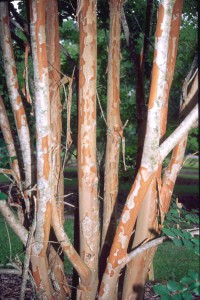
Apalachee Crapemyrtle Bark Photo Credit: UF/IFAS
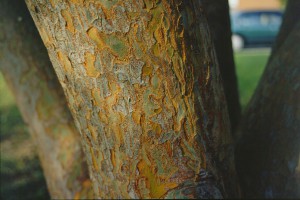
Drake Elm Bark Photo Credit: UF/IFAS
lia, Chinese elm, provide winter interest. “The showy, exfoliating bark reveals random mottled patterns of gray, green, orange and brown, adding great textural and visual interest, especially to its winter silhouette,” writes Ed Gilman, UF/IFAS Horticulturist, in his factsheet on Chinese Elm. This and other tree factsheets are available at http://hort.ifas.ufl.edu/woody. ‘Drake’ and ‘Allee’ are two popular Chinese elm cultivars. Chinese Elm can reach 80 feet in height but is more often seen at 40 to 50 feet with an equal spread.
American Hophornbeam, Ostrya virginiana, is an underused tree that grows to about 50 feet in height. Its grayish bark peels off in longitudinal strips revealing orange patches underneath.
Acer buergeranum or trident maple is a small, underused and hard to find tree. It usually is seen with multiple stems originating fairly low on the trunk giving the small tree a bushy appearance. It has noticeable orange-brown peeling bark.














